|
FAQs about Stony Coral Health/Disease/Pests
10
Related Articles: Coral Pests and Disease; pests, predators,
diseases and conditions by Sara Mavinkurve,
Quarantine of Corals
and Invertebrates, LPS
Corals, True or Stony Corals, Order
Scleractinia, Propagation for Marine
Aquarium Use,
Related FAQs: Stony Coral Disease 1, Stony Coral Disease 2, Stony Coral Disease 3, Stony Coral Disease 4, Stony Coral Disease 5, Stony Coral Disease 6, Stony Coral Disease 7, Stony Coral Disease 8, Stony Coral Disease 9, Stony Coral Disease 11,
Stony Coral Disease 12,
Stony Coral Disease 13,
Stony Coral Disease 14,
Stony Coral Disease 15,
FAQs on Stony Coral Disease by Category: Diagnosing:
Environmental (Pollution/Poisoning, Lighting...),
Nutritional,
Social (Allelopathy),
Trauma,
Pathogenic (Infectious, Parasitic, Viral)
Predatory/Pest,
Treatments
& By Family:
Caryophyllid Disease, Fungiid Disease, Faviid Disease 1, Cnidarian
Disease, Quarantining
Invertebrates,
|
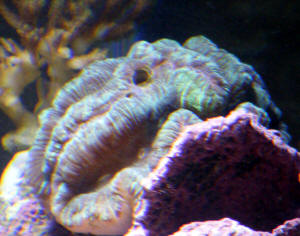
|
|
Multiple coral health issues - allelopathy?
6/6/13
Hello
<Hi there>
I have multiple corals in some type of distress at the moment and I
have not seen an obvious chemical or physical cause. I have
gone the first 10 months with zero issues, now this has popped up.
I have searched Borneman's book, your site, and the internet and
have not figured it out for myself. Perhaps you can help.
<Let's hope so>
Tank: 46 gallon, mixed reef, about one year old.
I have about one year's experience as a marine aquarist. Remora
skimmer, carbon and media in a canister filter. Carbon change
every 2 months (most recent one month ago), water change 10% every 2
weeks (Reef Crystals). Reef Fusion 2 part a couple times a week is
the only additive.
<Do you measure [Ca] and alkalinity? Mg concentration in balance?>
Water source is a deep private well with no chlorine or nitrates.
Fish: Green Chromis, midas blenny, royal gramma, Firefish, flame
angelfish.
Inverts: porcelain crab,
<Is this animal crawling over your corals?>
pom pom crab, cleaner shrimp, sexy shrimp (2), long spined urchin, dwarf
hermits (4), various snails, feather dusters (2)
Corals: Zoas/palys, toadstools, xenia, mushrooms, yellow
leather, bubble, chalice, monti's, small hammer, candy canes, finger
leather. All corals except those mentioned below appear healthy.
<Mmmm>
Parameters:
temp: 76
s.g.: 1.024-1.026
Ca: 420ppm
<Need to know [Mg]>
kH: 9
Nitrate: 0
<... need>
Phosphate: 0 (or very close)
<... your photosynthates need appreciable/measurable NO3 and HPO4...
can't live w/o>
Ammonia: 0
Issue:
1) Two candy cane colonies look very unhealthy. The heads
began to look clear and saggy, with the tentacles in affected areas
absent. Within the last week a neon slime has appeared in parts of the
polyp. The polyps are normally mint green, no neon at all.
At the same time, an adjacent neon green candy cane seems unaffected
even though a few heads were touching the sick coral. I have moved
it away.
<I see this>
2) A largish finger leather which is nearby to the affected candy cane
no longer expands much during the day. This has been about 2
weeks. In the past we would see this for a couple days then it
would shed some mucous and come back to it's original size. This
seems different.3) A Monti undata, also nearby, has changed in
appearance, becoming wrinkly and bumpy instead of smooth. It used
to be covered in visible white polyps, these have all but disappeared.
4) A Monti cap, also nearby, also had it's polyps disappear. It
used to look fuzzy, now it looks very hard. It has kept its color,
as has the undata.
5) A finger leather frag died. This was fragged off of the main
finger leather in the tank.
Possible causes:
1) Lighting. I changed lighting in February, from 96w T5
to 120w controllable led. I acclimated very slowly, stating at 40%
strength, increasing by 5% every few days.
<Mmm; not likely a principal source of trouble>
2) Allelopathy. In February I fragged the finger leather
as it was getting too close to the candy canes. Fragged
outside of DT, and kept frags and parent in QT until they were healed
about a week. Although all these issues are on the side of the tank
where the finger leather lives, I don't know why this would come on
suddenly. The candy canes were added last August, the finger
leather last September. No change in their locations since. After
reading through your advice I think you will say that this is the cause.
<Could well be>
3) Parasites/disease. I do not see anything on them. All
heads appear to be affected equally.
<I discount this as well>
The finger leather may be the culprit, but I hate to pull it out of the
tank without knowing for sure. Perhaps you have seen a candy cane
coral with this appearance before?
<Yes; due to allelopathy... chemical and physical warfare w/ other
Cnidarians>
Are they capable of recovering at this point?
<Oh yes; certainly>
Any help would be appreciated. Thank you for your time.
Paul
<Well; there are a few paths, steps you can take to alleviate the
allelopathy... Read here re:
http://www.wetwebmedia.com/cnidcompppt.htm
and the linked files above... Again, you want to allow (likely by simply
stepping up feeding) some NO3 and HPO4. Bob Fenner>
|
.jpg)
.jpg) |
|
Tissue Necrosis, Discoloration, and White Excretions
on SPS/LPS 4/21/10
Hi there and thanks in advance.
<Welcome Aaron>
I've recently run into some trouble with my year old 47g
mixed reef. Over the past few days I've noticed some
startling tissue necrosis and zero polyp extension as well as
general paling out of colors on a relatively localized
section of my display.
<I see this>
The affected corals include Cyphastrea, a Favites (possibly),
several encrusting Montiporas, two Acropora colonies. In addition
to the tissue necrosis I've noticed a white,
mucus/string-like excretion from the stony corals. I was careful
to verify this wasn't a Nudibranch or anything living.
Several weeks prior I added some clove polyps without dipping
them (I'm ashamed to say) but would think that if this was
something I had introduced with them it wouldn't be affecting
such a wide range of coral in similar ways.
<Likely just an interaction (allelopathy) w/ the Clavulariids
period...
Read here: http://wetwebmedia.com/polypcompfaqs.htm
Perhaps a "cascade event" twixt them, the Zoanthids,
Euphyllia in turn to all>
I should note that a frogspawn, numerous Zoanthids and several
other LPS corals, as well as a Pocillopora are in the general
area and not exhibiting symptoms.
<The "winners">
I also ran a battery of tests with the following results:
Salinity: 1.025 Ammonia: 0ppm, Nitrite: 0ppm, Nitrate: 5ppm, Mg:
1200ppm, Ca: 440ppm, Alk: 5.9 dKH, pH: 7.8. Further investigation
yielded a heater plugged into a surge protector which had been
turned off/blown within the last few days (not quite sure when).
Thankfully, the ambient temperature is around 75 but it is likely
that there were some temperature swings over night. Despite the
low pH and alkalinity levels (which are being rectified), I'm
not certain that the parameters or temperature is causing the
problems as there are numerous corals (various Acroporas,
Blastomussa, xenia, clams) that I would have thought to be more
fragile in other portions of the tank that as of yet appear to be
doing just fine.
I'm hoping for some sort of recommendation for treatment.
<... chemical filtration, water changes... taking out the most
likely offenders, slowly re-acclimating them through
water-mixing... Read here: http://wetwebmedia.com/cnidcompppt.htm
and the linked files above>
Obviously getting the parameters back in check is a priority (and
I'm hoping your opinion is that this is the root cause as
it's easily fixed!). I did a 30% water change yesterday and
plan to continue this for a number of days in case something was
accidentally added to the water (although, again, the localized
nature of the problem makes me wonder whether that could be the
case.
Unfortunately, a freshwater dip for the corals would be quite
difficult to manage as many of them are encrusted on a very large
rock but if it meant containing the spread of something
potentially lethal to my entire aquarium, I could find a way.
I have attached pictures of several of the affected corals for
your inspection. Please advise!
Thank you,
Aaron
<The most likely scenario/cause here is Cnidarian
allelopathy... Read where you are referred to. Bob Fenner>
|
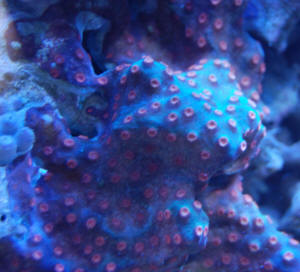 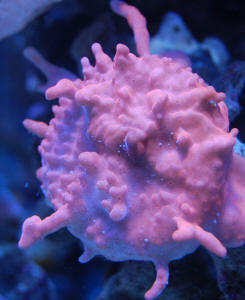
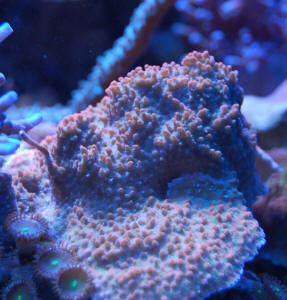 |
|
Trouble Keeping Hard Corals Alive 3/19/10
Hi there, I have a question,
<Hello Mike>
We are having trouble keeping our Hard corals alive.
We have done all the tests and here are the results:
Ammonia 0.15 - 0.2
<This should read 0>
Nitrate 50 - 110 ppm
<Way too high for keeping corals and tangs/sensitive
fish.>
Nitrite 0.1
<Should also read 0>
PH 7.8 - 8
Calcium - 420ppm
Alk 3 MEq
Copper 0
phosphate 0
Chelated Copper 0
Silica 0.01
We have done 3 - 10% water changes over a 2week period, and the
nitrates are just not coming down.
<Not going to help much with your fish load.>
That seems to be the levels that are a little higher then what
they should be.
<Not a little, much higher than they should be. Your biggest
problem is that you are overstocked with fish, which produce
waste, which also produces nitrates. You do not mention the use
of a protein skimmer and this is necessary to control/reduce
nitrate levels providing the waste isn't being imported
faster than it is being exported, and this my friend is your
major problem and is the reason why you are detecting ammonia and
nitrite. The system cannot keep up with the biological load and
this load needs to be reduced or you will be losing fish due to
environmental stress in the very near future.
I'm guessing your tank is a 46 gallon bowfront, and I might
add that this is too small a volume for keeping tangs
with any long term success. Maintaining/growing hard corals also
requires intense lighting, and you do not mention the
type/wattage of lighting you are using. Do read here and related
articles/links in the header above.
http://www.wetwebmedia.com/nutrientcontrol.htm
http://www.wetwebmedia.com/nitratesmar.htm
http://www.wetwebmedia.com/growingcorals.htm
http://www.wetwebmedia.com/ca/volume_2/cav2i6/Reef%20Ramblings/ramblings.htm
>
Any help would be greatly appreciated,
<Do read. James (Salty Dog)>
Best regards,
<Ditto>
Mike Ezekiel
|
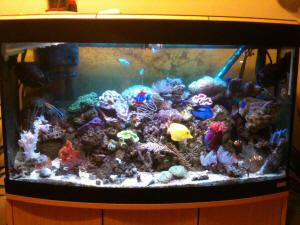 |
I have both white band and black band infections --
2/3/10
and have researched it extensively but have found no cures ???
<On/with your Stony corals I take it>
I have a coral/fish 210 show tank with a basement cascading through 3
75 gal deep sand beds with Chaeto Caulerpa and mangroves that also has
a 210 gal in line tank that cycles through a 50 gal sump with uv
ozone
<What is your ORP reading?>
and many 100 micron sox that are changed regularly all parameters are
fine except nitrates at 5
<Five ppm isn't bad. What do you have for HPO4? Do you utilize
chemical filtrants? What re Ca, Mg, Alkalinity? Something is likely off
environmentally here>
(lots of fish to feed) if I segregate the corals is there an anti
biotic treatment
<I would not use such here>
and if so how applied I have lost 2/3 of both soft and stony corals and
want to try and save my last pieces ????? help !!! thanks Paul Garlasco
friend of rob brays (house of fins in ct )
<Mmm, can you send along some pix of the malaffected colonies Paul?
And the data requested above. Bob Fenner>
Re: sorry about the caps I have both white band and black band
infections -- 2/3/10
orp is 350
<Good>
po4 is 0
<Not good. All life requires some "free" phosphate...
Whatever is removing all, you should take out>
chemical filtration is 6 poly pads rolled and caulked and capped in 100
micron sox with 400 gal/hr pumps alkalinity is at 110ppm ill try to
shoot you some pics also I'm getting a bubbled reddish carpet on
much of my live rock ???
<Indicative of? Likely Cyanobacteria. Again, summat is off here
environmentally. BobF>
|
Cyano, algicides admonition
1/13/09
Hi Crew,
I have been battling red slime for a few months and made a lot of
progress but could not get it completely. It was contained in a
few spots that I would siphon. Every once in a while it would
flare up and I would have a real clean up to do. So I decided to
try a product despite the problems people have reported.
UltraLife Red Slime Control.
<Hmmm'¦.>
My tank is just a 10 gallon and I have candycanes and some fish.
Instructions were to use one measure of the enclosed dispenser (
one flat teaspoon full) for 15 gallons. I figure I have about 8
gallons so I used half of that. I pre mixed it with tank water
until completely dissolved as instructed. And it did get rid of
it. My tank always had a reddish hue to it and now it actually
looks very clean. The fish did not seem to mind the treatment. I
have a few snails and I did not notice any adverse affects. The
corals did not like it. It was nothing major but I rarely see
them with open mouths, usually just a few.
<I have seen this, a friend just wiped out his reef recently
using a similar antibiotic product.>
But during the treatment they were all open. I left it this way
for 2 days. Then I put carbon back in my filter and did some
water changes and so far, after a week, all seems well and it has
not returned (yet).
<It will unless the fueling factor is addressed. These
treatments are a temporary fix and a poison to filtration. The
tank inhabitants are threatened initially by oxygen deprivation,
followed by a hit to the biofiltration. See the links below for
more re this and the BGA.>
Thanks,
Sam
<Welcome, Scott V.>
http://www.wetwebmedia.com/maralgcidefaqs.htm
http://www.wetwebmedia.com/bluegralgae.htmCyano Control 1/13/09
Hello Crew:
<Tom>
As Always I must say Great Site! Tons of information which I read
daily and then some.
<Great!>
My tank is a 3-1/2 year old 46 gallon bow with the following:
1-2" crushed coral (which I plan to create DSB 4-6" I
have the sugar sized sand but lack the confidence to create
without killing my tank family)
<Ah, just add a bit at a time over a couple of weeks and you
will be fine.>
50+ lbs of LR
Fluval 404 - took all components out and added Chemi-pure Elite
and charcoal
<Redundant, save yourself some cash and use one or the
other.>
Aqua C Roma w/Maxijet 1200 and drain hose (upgraded about 2
months ago from Prizm)
<Good move!>
2 power heads for water movement
Coralife 36" compact fluorescent dual 96w (1-daylight,
1-Actinic)
Readings:
SG - 1.023
Phos 0-0.25 (color chart)
Cal - 300
KH - 7
PH - 8.2
Ammonia - 0
Nitrite - 0
Nitrate -10
Temp - 80 F
2 false clowns - had almost 3 years
Yellow Tan
g - 1-1/2 years
2 cleaner shrimp - 6 months
Several various hermits
Several various snails
Frogs spawn - 2 years (had 2 heads and now has 4)
Yellow Polyp - 1-1/2 years
Green Polyp - 2 years
Several Mushrooms - 2-1/2 years
1 Ricordea - 2-1/2 years
1 leather - 1 year
2 nice size pieces of candy cane - 1 year
I believe my tank has a Cyano problem. The back of my tank ended
up covered with dark maroon color algae which I scraped off like
wall paper. But it also covered much of my LR. How do I clean the
LR?
<Best to just scrub in the tank a bit, siphon off what you can
with water changes. Treating the cause is the real cure.>
Can I remove some LR to open up the tank a bit?
<You can.>
Should I be doing something different or in addition in order to
remove the Fluval 404 canister?
<Start here: http://www.wetwebmedia.com/bluegralgae.htm
Continuing through all the linked files above will tell you more
than you ever wish to know about your problem!>
Thanks,
Tom
<Welcome, Scott V.>
Re: Cyano Control 1/14/09
Hello Scott:
Thank you for the information.
<Happy to help out Tom.>
I will keep reading WWM & learning.
Do you think at some point I would remove my Fluval 404
completely and relay on my LR & skimmer?
<I would, it is of little benefit with your other filtration
in place while just providing a possible detritus trap and extra
maintenance.>
Thanks,
Tom
<Welcome, Scott V.>
Re: Cyano Control... and Scler. hlth.
01/19/09 Hello Scott: I seem to have a possible problem
with my Candy Cane & Frogs Spawn coals. The Candy Cane always
seemed to have plump looking heads and all of a sudden they
appear hard for at least a week. The Frogs Spawn for about 2
weeks has not been fully out the tentacles are very close to the
skeleton. I kept thinking that they were disrupted yet its been a
while. Water has not changed as listed in earlier email.
<Hmm... I don't know, but it could be a reaction to the
Cyano.> Not sure whats going on. <When in doubt, do a water
change.> Regards, Tom <Best, Sara M.>
Re: Cyano Control 01/19/09
Hello Sara: Thanks for the response. That's exactly what I
did tonight and will keep doing them. Another thing I noticed is
that my snails are not acting right. Astraea & Margarita
snails seem to have slowed down and appear to be having trouble
moving and some are extended. Another thing I had been doing
often was blowing off the LR with a turkey baster and doing the
same to the 1-2" crushed coral on the bottom stirring it up.
The reason I was doing that was to allow the protein skimmer to
clean the water. Is that ok? <Yes, this is even recommended.
However, if your tank is not "used to" it, you might
have stirred up too much too fast. Again, the only really remedy
for this is more water changes...> Regards, Tom <Best, Sara
M.
|
RTN Theorizing 12/24/08 Hi Crew, <Hello Jason.
Minh at your service.> It's been a long time since I've had
to write you with a problem. That's good! Unfortunately, one of my
beautiful and large Birdsnest just underwent rapid tissue necrosis
(RTN). It happened frighteningly fast; in less than a day the
grapefruit-sized coral went from healthy to half dead! <I'm
sorry to hear about your loss.> While my particular cause is unknown
(I suspect encroaching mushroom corals, but unsure), I noticed
something interesting. The death progressed along the branches of the
coral, not simultaneously. In fact, it spread from base to tips (oldest
to newest growth). I understand this is a common pattern. In an attempt
to save as much as possible, I broke off branches that were still alive
and discarded parts that were totally bleached. <Rapid Tissue
Necrosis (also known as apoptosis) is a cellular reaction in corals
initiated by various stresses such as bacterial infection, temperature,
UV radiation, allelopathy, etc. In this particular case, the
encroaching mushroom is a very capable culprit.> More interesting:
the frags that had some dead tissue still on them proceeded to degrade
in the same manner. Those that were comprised only of living tissue
appear OK. <If the tissue on a fragment is undergoing apoptosis, it
will continue to degrade until the fragment is dead. I would suggest
for you to quarantine any remaining healthy fragments in a separate
tank to isolate the cellular reaction. This would allow for the highest
survival rate of your Seriatopora guttatus while reducing any risk of
exposing other healthy SPS corals to this condition.> This is very
puzzling. If this condition was caused by a biological or chemical
agent attacking the coral flesh, one would expect that it would either
be localized (killing a small area) or all over (killing patches at
different places on the coral simultaneously). The fact that the
progression moves very predictably along the branches implies, at least
to me, that it is innate behavior of the organism, not the result of
attack. Perhaps it is an evolved survival mechanism; a last-ditch
effort to abandon the skeleton and grow anew somewhere else on the reef
more amenable to the coral's health. In our tanks, of course, that
would not happen thanks to lots of factors, but possibly on the reef?
This may explain why the frags without dead patches survive: the signal
to eject never reaches them, so they persist. Do you know of any
research in this regard? Thoughts? <Although I have seen broadcast
reproduction occur in a similar manner, and some rare instances in
captivity, the behavior of tissue necrosis appearing in a predictable
band pattern indicates a classic case of apoptosis. This cellular
reaction could be triggered by allelopathic attack from a neighboring
soft coral. Further reading on this subject is available in an
excellent article by Eric Borneman, "The Coral Health and Disease
Consortium: New Information on Coral Disease." Link:
http://www.reefkeeping.com/issues/2002-03/eb/index.php.> Thanks!
Happy Holidays! Jason <Likewise to you and yours. Cheers,
Minh.>
|
Foraminiferans Irritating Corals?
11/21/2008 Hello to whomever is answering emails today
:D <Hi Miguel, Mich here.> I've been having an issue
with what I think are Marginopora vertebralis, which I just
Id'd thanks to the handy search function on your site.
<Looks to be so.> For a back story, I've had issues
in the last few months with LPS peeling slowly, and every time
on the peeling flesh I find these Foraminiferans. It seems like
they're slowly irritating the corals to death as they feed
on whatever it is that they're feeding on the live rock.
<Mmm, does not necessarily make it causational.> I've
included a picture of what I think is them irritating a coral.
<In researching I have not found information to support
this, but that does not mean it is not possible.> This is
how all of the peeling LPS tissue in my tank looks like, you
can see that at 12 and 6 o'clock they are digging into the
flesh of the coral, and especially at 5 o'clock you can see
a smaller one digging into the coral with a distinct peeling
flesh next to it. <This is unusual.> At the very bottom
right of the image you can see them working into the flesh as
well, and in the top left there is a white spot on the coral
that's actually another one that has just attached. <I
see.> I'm not sure if these are the cause of the problem
or just bystanders in another tank issue that may be going on,
but it's a bit coincidental that they're always right
at the edges of the peeling sides of the corals. <Some types
of Foraminiferans feed on bacteria, perhaps the Foraminiferans
are feeding on areas of decay.> One of my friends had a
microscope, so I'm attaching several highly magnified
images in order of magnification. <Cool!> They average
about 1mm across, and in picture 4 there is a blob of green.
<I see.> I'm not sure what that is but it's the
only block in the Foraminiferan that had one in there, possibly
it's feeding on it? <Is a possibility.> Thanks very
much for your time, and I hope things are well! <Thank you
Miguel.> Miguel <Cheers, Mich>
|
|
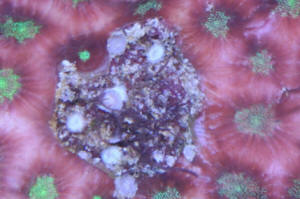
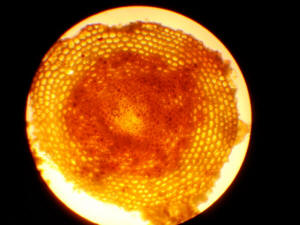
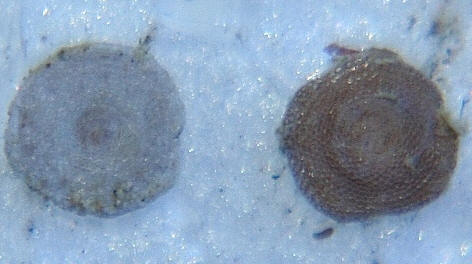 Nice pix! RMF Nice pix! RMF
|
|
Hole in my Wellsophyllia brain coral 11/09/08
Hello, <Hi Tamika, Mich here.> I just purchased
Wellsophyllia brain coral from my local store. When we arrived
home we noticed that there are a few holes in it and they look as
though they were drilled. <Well sort of.> They are
perfectly round. <I see.> One is about 3/8" diameter
and the other 2 are around 1/4" diameter. <Ok.> I am
quite concerned, <No need.> and the store where I bought
them say they are "mouths" but we can see the
"mouths" and they are not the holes I am looking at.
<They are not mouths.> Is this some kind of a parasite?
<No.> Is this going to hurt the rest of my tank?
<No.> We trust the dealer, we have brought home a few
bristle worms from him, <Again, nothing to worry about, as
long as they aren't huge.> but nothing too terrible.
Thanks for your time. I am attaching a couple of pictures.
<These are the homes/former homes of some sort of polychaete
worm, ie a feather duster or the like. Nothing to worry about.
Enjoy your beautiful brain.> <Mich>
|
  |
|
|

